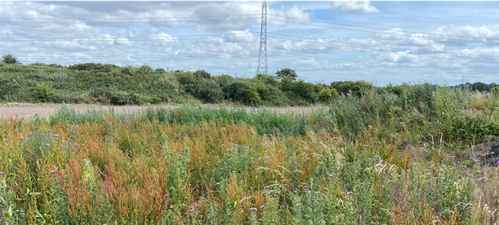
RammSanderson was commissioned by AT Contracting & Plant Hire Ltd to undertake an Ecological Impact Assessment at Barrow Hill Quarry (disused), Earl Shilton, Leicestershire, to inform a planning application for the construction of holiday lodges at the site.
The key objective of the Ecological Assessment was to identify any
ecological features and assess any risk the construction of holiday lodges may incur upon them. Our commission was to provide a detailed assessment on the ecology of the site and the species it supports, to provide advice and to help to inform the proposals - this has included:
- Desk Study Consultation
- Extended Phase 1 Habitat Survey
- Species specific surveys; birds, bats, reptiles, badgers, terrestrial invertebrates, and great crested newts
- Biodiversity Index Assessment (BIA)
The Assessment
The habitats at the disused Barrow Hill Quarry were mostly dense continuous scrub and bare ground, with small parcels of semi-improved grassland, tall ruderal, and disturbed areas, including ephemeral/ short perennial habitat.
These habitats have the potential to support priority/protected species, but due to the site being highly disturbed by recreational activities, the species found on site were limited.
A range of bat species were recorded foraging and commuting, and of the birds recorded on site very few were of conservational concern. The pond adjacent was assessed as being unsuitable for Great Crested Newts (GCN) due to its stock of large fish. As the other ponds were inaccessible, the client joined the GCN district licence scheme - this monetary compensation provides funding for off-site habitat. Several indicators of badgers were found on site including footprints and hair, trail cameras aided in confirming badgers frequented the site. The flora on site was deemed valuable for invertebrates however, the habitats on site were relatively small and subject to high disturbance, it would therefore not support large populations.
Overall, it was deemed unlikely the site would support significant populations of terrestrial invertebrates, reptiles, birds and bats. However, due to the habitats on site being suitable for these species, their presence on site cannot be discounted.
Recommendations
The survey findings and reports will inform the proposals for the site and the necessary mitigation or compensation measures whilst seeking to enhance the site for its native flora and fauna. Specific recommendations were made for the removal of invasive Japanese knotweed and providing further habitat. The recommendations for native planting and species-specific refuge have resulted in a net gain of biodiversity.
RammSanderson has a team of experienced consultants ready to support your project. Visit our Preliminary Ecological Appraisals page to learn more!